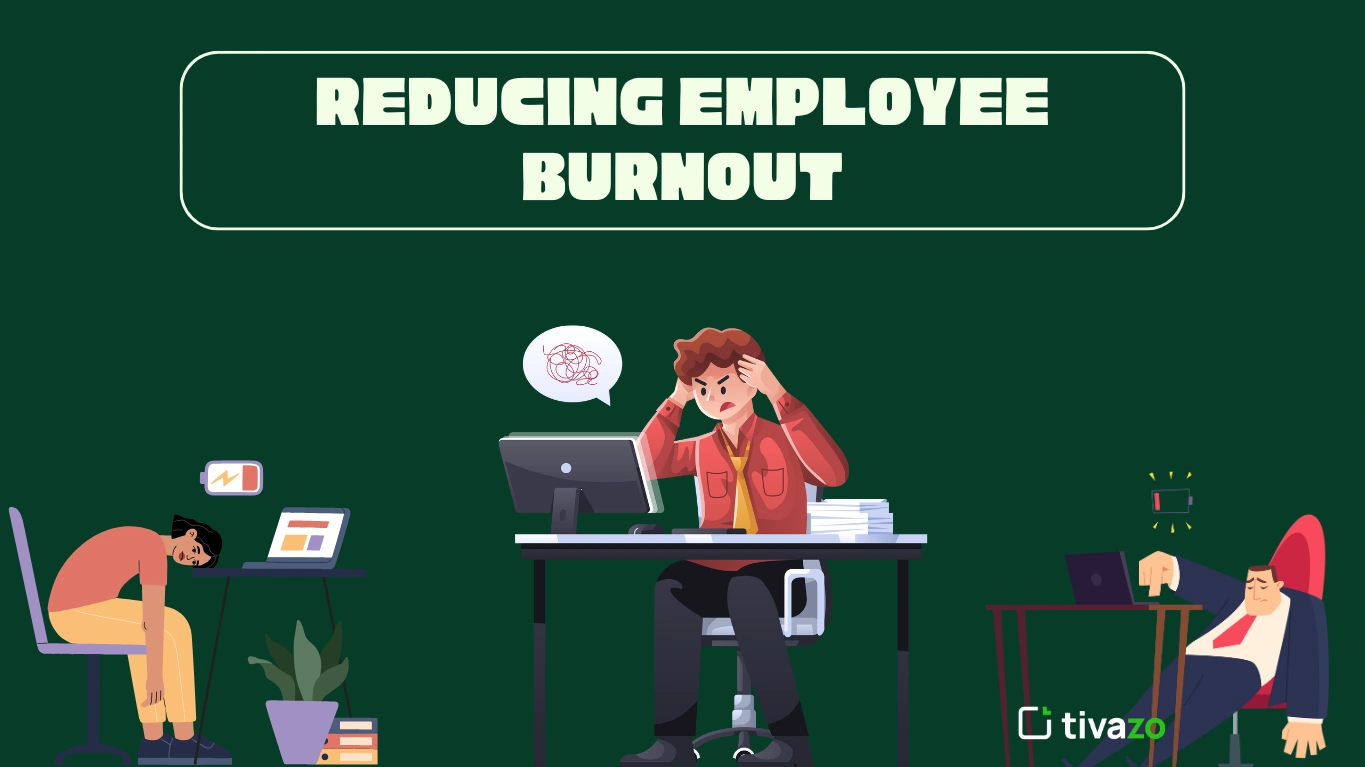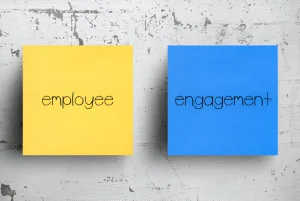Employee burnout is a chronic state of physical and emotional exhaustion. It is not a temporary post-work feeling that is too much work, but a real workplace problem that can undermine performance, morale, and physical well-being. A study states that in the US alone, 44% of employees complain of burnout, and employers lose between $4,000 and 21,000 per staff member per year. In the world, the World Health Organization has acknowledged that burnout is the effect of chronic stress at work. Otherwise, stress among employees rapidly develops into burnout, which neutralizes people and institutions.
This post will help leaders, HR teams, and managers know what can be done to reduce employee burnout, protect mental health, and increase productivity. We plunge into the symptoms and cost-related implications and describe evidence-based prevention strategies.
What Is Employee Burnout?
Employee burnout is not just being overwhelmed; it is a long-term condition that is characterized by three dimensions:
- Emotional exhaustion: the feeling of being emotionally spent and incompetent.
- Depersonalization or cynicism: the loss of a caring attitude toward work or co-workers, replacing them with a detached, cold attitude.
- Less personal accomplishment: the person is less able and effective at work.
The reasons include too much work and lots of hours, lack of recognition, and control. In a report conducted by Flair HR in 2024, it was identified that:
- 94 percent of employees had chronic stress at work.
- 32% suffer emotional exhaustion
- Physical fatigue has risen 38% since 2019
However, burnout is not a job only of white-collars. According to research, about half of the medical workers experience burnout in health institutions . According to the American Psychological Association (APA), stress-related deaths around the world amount to 120,000 deaths in the U.S. alone every year. The statistics seem to provide a clear indication that employee burnout is not uncommon; it is an epidemic at the workplace that must be heeded.
The Link Between Employee Stress and Burnout
Employee burnout, in short, entails employee accumulated stress. Emotional and physical well-being are depleted by sustained job demands such as unrealistic deadlines, unclear expectations, and a lack of support. A Hubstaff study found that:
A Hubstaff survey found that:
- 79% of workers cited chronic employee stress as a major concern
- 60% acknowledged a severe impact on well-being
- Half said it affected their personal lives
According to Flair HR, 8 out of 10 employees in the U.S. have a job-related stress problem, and most of them are 2.5 times more likely to change jobs. Employees who are burned out also have more sick days by 63 percent; the chance of emergency care is 23 percent higher among the burned-out employees.
The Harvard Business Review puts the estimates of burnout costs in U.S. healthcare organizations at 125B to 190B a year. It is a drain that can not be sustained, and the corporate entities should address this straight away by putting measures to curb work burnout among employees.
The True Cost of Employee Burnout
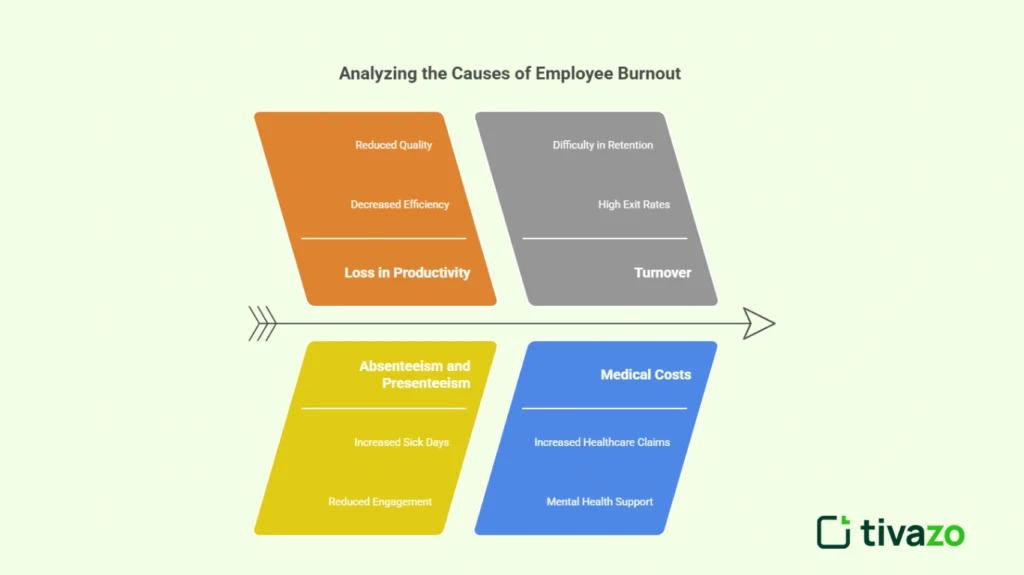
Not only is burnout harmful to the person but also it affects the bottom line in quite a serious way:
- Loss in productivity: Burned-out employees are pegged at 63% less productive, with an average loss of productivity of $12,000 in every staff member each year.
- Absenteeism and presenteeism: Employees who are unengaged miss more time and are less productive when they do work, and the resulting loss costs companies up to 150 billion dollars annually in the U.S. alone.
- Turnover: Burnout leads to the draining of talents. The cost of replacing a mid-level employee is 20-30% of a yearly salary, whereas the outgoing staff places burnout is the top #1 reason in their resignation letter .
- Medical cost: High stress levels are associated with increased healthcare expenditure and medical claims. Researches indicate that along with burnout, healthcare expenses rise by an average of 50 percent .
On the whole, employee burnout brings about an annual loss of up to 300 billion dollars in the United States. It is a lot more than your typical company is paying, even in the entirety of its employee wellness programs. When you position burnout prevention as a financial investment, it will provide a high ROI and the best part is that you can initiate 10 strategic steps today!
10 Proven Strategies to Reduce Employee Burnout
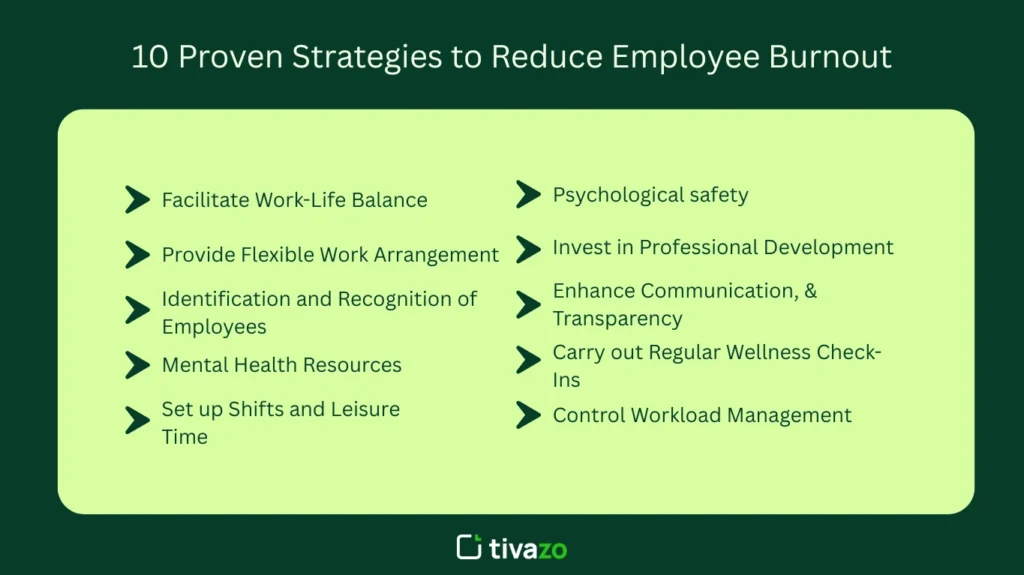
The following are short- and long-term plans, which will enable you to minimize employee burnout and reverse employee stress:
1. Facilitate Work-Life Balance
One of the best ways through which worker burnout can be minimized is by encouraging a good work-life balance. This also involves imposing realistic workloads, email discouragement in after working hours, and personal time. Employees with a healthy work-life balance will work 21 % more with a high degree of productivity and will be too loyal to the firm and are much less prone to employee burnout.
2. Provide Flexible Work Arrangement
Offering flexibility to employees through means of remote work, hybrid model or compressed workweek enables them to organize their day according to their most productive hours and personal obligations. McKinsey reports that 40% of remote workers have shed some stress levels, so flexibility would be an effective way to reduce employee burnout.
3. Identification and Recognition of Employees
Words of appreciation are the best. Morale can be raised through such things as public recognition, performance bonuses, and simple notes of thanks. In companies that have a good recognition program, the turnover decreases by 31 percent and the employee engagement rises to 14 percent, which makes it easier to curb the issue of disengagement and burnout.
4. Mental Health Resources
Employees can use various tools to help them deal with stress: access to mental health services (therapy, coaching, mindfulness apps, and mental days off) help to work through stress. Once such resources are readily available and stigma-free, there is a higher possibility of employees seeking such assistance which results in fewer sick days and a reduced risk of burnout.
5. Set up Shifts and Leisure Time
Recharging is vital through short frequent breaks, and taking all the PTO. The rest is a way to reset the mind and emotional strength. Studies indicate that taking a brief break can enhance one 13 % better in concentration. Employees who utilize their vacation time are not likely to experience employee burnout.
6. Control Workload Management
One of the major reasons why employee burnout takes place is unmanageable workloads. Project management tools enable the employers to keep track of how the tasks are being distributed, assign realistic deadlines, and even redistribute the tasks. Those teams that have a balanced workload experience a 20 percent reduction in stewardship-related absences.
7. Psychological safety
It is necessary to develop a culture in which the employees can safely speak up or seek assistance or beg forgiveness without fear of being judged. Psychological safety has been attributed to
(a) an increase in team performance by 35%, and
(b) a relatively low level of employee stress.
8. Invest in Professional Development
Employee burnout is usually based on stasis or the feeling that you are underestimated. Employees are more driven when companies provide them with learning and career development opportunities. In organizations that value development, burnout levels decrease by 34% and the retention levels increase.
9. Enhance Communication, & Transparency
Misunderstanding and anxiety are created by vague objectives and lack of communication. Frequent communication, setting expectations, and open communication get rid of ambiguity. Physical jobs with high communication clarity have up to 50% reduction in stress, and the outcome is a better culture and output.
10. Carry out Regular Wellness Check-Ins
Regular pulse checks, individual meetings, and feedback tools that do not bear the knowledge of the participants can help the leaders address the mood of their teams. Such check-ins trigger red flags early, and research indicates that frequent check-ins on wellness reduce 30% burnout risk.
The Role of Leadership in Preventing Burnout
Leaders have a key role in the development of a healthy and sustainable work culture. The leadership can considerably assist in minimizing burn-out among employees as well as alleviating long-term employee stress when it is empathic, communicative, and proactive.
Deloitte revealed that 77% of employees report feeling burned out at their current job, and 70 % feel that their employers could do more to avert it. Even such disconnect signals that the leadership should place a greater emphasis on employee well-being, not only in policy but also in practice.
How Leaders Can Help:
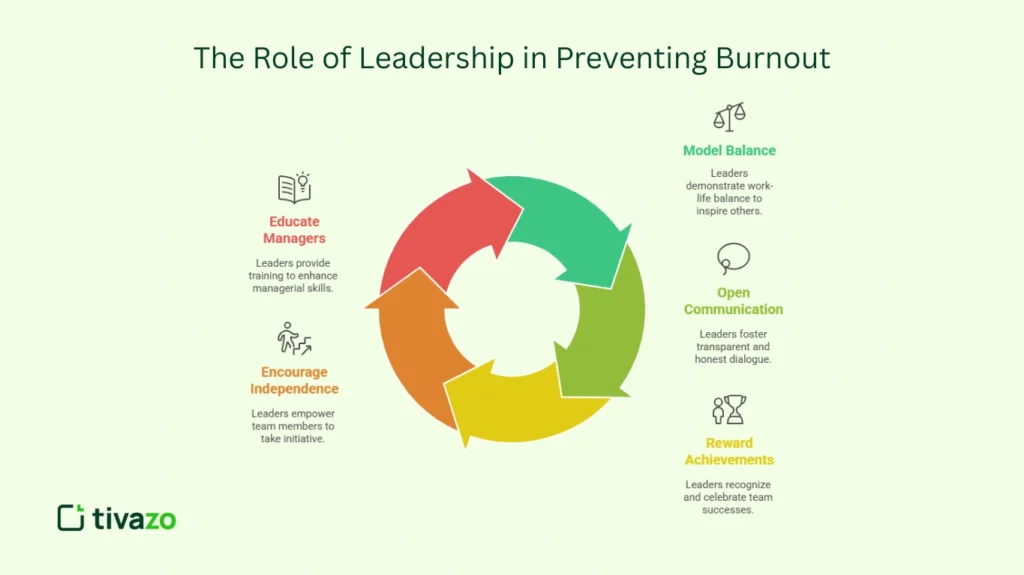
- Model balance: Culture means that when managers work late at night or do not take vacations, it becomes a precedent. Healthy work habits should be practiced and demonstrated as leaders.
- Have open communication: Employees must feel secure to communicate and the effect is that they are more willing to express stress factors before burnout arises. To build trust, the leaders can listen, respond to feedback, and ensure frequent checks.
- Reward the achievements: Recognition decreases stress, and increases motivation. It is enough to say a simple thank you in public or a simple acknowledgment.
- Encourage independence: Allow the staff members to make decisions and work on their schedules. A quick road to burn out is micromanagement.
- Educate managers: Managers who are supervising people should be taught that they need to be aware of early symptoms of burnout which may include irritability, absenteeism or reduction in performance.
According to Gallup, at least 70 percent of employee engagement varies with managers, and therefore, managers sometimes must play the critical role in keeping burnout at bay. An effective way to prevent burnout is a leadership that is intelligent, receptive and helpful.
Measuring and Monitoring Burnout
There are things that you cannot repair, which you do not monitor. One of the necessary measures a company should take in order to minimize the problem of employee burnout is a periodical assessment of stress levels and mental health rates in the workplace.
Strategies and Tools:
- Pulse surveys: Short surveys taken regularly in order to monitor employee mood and stress over time. It is possible to question workload, support, recognition, and overall well-being.
- Burnout tests: Apply well-developed questionnaires such as Maslach Burnout Inventory (MBI) or Copenhagen Burnout Inventory (CBI) in order to discover areas of concern.
- Manager 1:1s: Constant meetings with managers provide a worker with an opportunity to confide his or her worries and be listened to.
- Anonymous feedback mechanisms: The existence of suggestion boxes or the anonymous filling of online forms can allow sincere reporting of stress and burnout at the workplace without the fear of reprisals.
- HR analytics: Tracking absenteeism, turnover, productivity, and PTO utilization as an indicant of an early-stage burnout on a large scale.
HR.com has reported that the companies monitoring the employee wellness record a 60 percent increased engagement and 41 percent reduced absenteeism. Incorporating wellness statistics into business KPIs will make companies send a message to employee that their health is as important as profits.
The Long-Term Benefits of Reducing Employee Burnout
When companies invest in long-term burnout prevention, personal payoffs are not the only ones; they are financial and cultural as well.
This is what the statistics indicate:
- Better employee attraction and retention: According to a study conducted by Limeade, the same employees who feel cared about are 4 times less likely to burnout and 5 times more likely to remain in their employment.
- Equity issue: 1 employee in 5 heads is ready to change workplace due to job burnout (MedScape).
- Cost saving: Turnover, absenteeism, and health-related cost-cutting save companies millions of dollars each year.
- Enhanced ecosystem: A culture of well-being leads to collaboration, trust ,and innovation.
Improved employer branding: Employers who practice wellness have an advantage in the recruitment process due to the popularity of wellness-oriented workspace among the best employees and talent in general.
Burnout prevention is not a simple patch but a culture change in the long-term. However, that change is worth it. Companies getting serious about burnout are returned with healthier personnel, higher productivity and competitive advantage in hiring and retention.
Conclusion
Burnout is not the problem of an individual, it is about overwork, boundary issues, and persistent stress. Employee burnout is insidious drain on your company’s productivity, morale, and retention unless the problem is addressed and eliminated. Nevertheless, the positive thing is: that burnout can be avoided.
Businesses should not act in response to worker burnout. By that, we need to establish the culture of work-life balance, the encouragement of leaders in regards to mental health issues and enabling the employees with a sense of freedom and meaning. It also implies monitoring indicators of employee pressure on a regular basis and acting, not just providing some superficial benefits.
The more efficient organizations that will close the decade will be not only the best but also the most human. Today the investment you make in the well-being of your people will reward you tomorrow in loyalty, innovation and performance.
You should not wait until burnout takes away your best talent. Get started, get small and be persistent. Your bottom-line as well will appreciate it, and so will your people.
